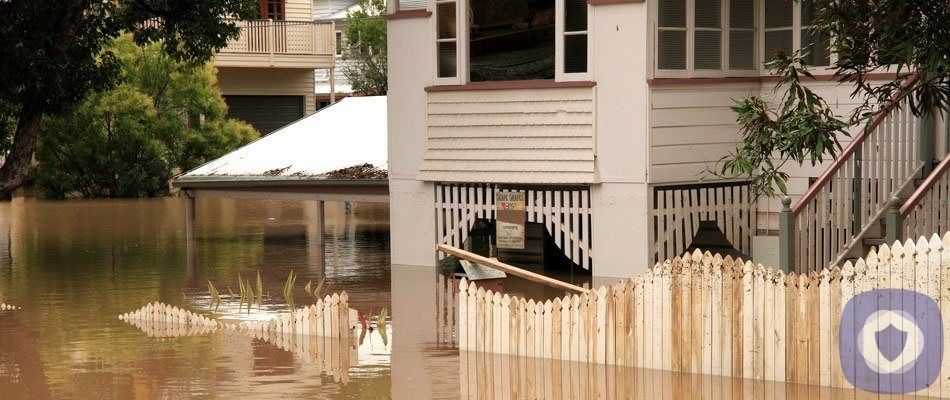Water can do a lot of damage. Even minor flooding can compromise the structure of a home and cause damage that could affect your and your family’s health. According to FEMA and The National Flood Insurance Program, just one inch of water could cause over $25,000 in damage to a home.
A flood can happen because of a natural disaster or because of a plumbing problem, like a broken pipe or a broken appliance, such as a dishwasher.
If you experience a house flood, it’s normal to want panic, but know that you can likely remediate and repair.
What to do in the case of a flooding emergency
1. Stop the Water, If Possible
If you’re experiencing a plumbing problem and it’s possible to stop the water flow in some way, such as shutting off a water valve, do it ASAP. This can prevent any further damage to your home.
2. Cut Off Power
Standing water can carry an electrical current, which is a major safety hazard. When water and electricity mix, it can cause electrical shock or even start a fire. If you can easily and safely get to your fuse box or circuit panel, turn off the power.
But never walk through standing water that has electrical outlets and/or wiring submerged in them, since you could get electrocuted. If you can’t get to your fuse box safely, call an electrician instead.
3. Call for Help
If anyone in your home needs medical attention or if you need help getting out of your home, call 911.
In addition to emergency services and possibly an electrician, you may also need to call a plumber to help you fix any problems that are causing the flooding, such as a broken toilet or clogged pipe.
Steps to take if your house floods
4. Locate any important papers
If you’re not in imminent danger and can get to them safely, locate any important papers. This may include personal identification, proof of home ownership, homeowners’ insurance documentation and flood insurance documentation.
5. Leave the home if you’re in danger
In a flooding situation, you should always gauge your and your family’s safety first. If staying in your home is risky, leave as soon as possible.
Remember that drowning and electrical shock aren’t the only safety hazards flooding can cause. Bacteria and mold could jeopardize your family’s health. Plus, water damage can weaken a home’s structure, making it potentially dangerous to stay.
Evaluate the situation—often, this has to happen quickly—and err on the side of caution. Find somewhere else to stay temporarily. In the case of a natural disaster, you may be able to stay in an emergency shelter.
If your area is evacuated, wait until authorities say it’s okay return to your home to do so.
6. Keep everyone safe
Until everything’s cleaned up and remediated, keep pets and children supervised and away from dangerous areas of your home. If your running water could be contaminated, don’t drink it, and don’t use it to wash dishes or hands, to brush teeth, or to prepare food or drinks (like for ice or to mix baby formula).
7. Call your insurance company
You may be able to file an insurance claim, depending on what your policy covers. Coverage could include home repairs, replacement of damaged possessions and even a place to stay. Call as soon as you can, so your company knows there’s been a flooding event and so you know what they expect as far.
8. Document everything
Once you can safely return home, take lots of pictures. You’ll want documentation of the flood damage to your home and to your possessions. This is an important part of filing an insurance claim. For example, your insurance company may want to see how high the water damage was on your walls. It’s important to take a photo before any drywall is removed and replaced. The company may send an adjuster to your home to evaluate the damage as well. You may be advised not to make any repairs until this happens.
Save receipts for remediation, cleanup, repairs and expenses, such as hotel and meals, if your policy covers those as well.
9. Dry things up
To prevent mold from damaging your home and creating a health hazard, you’ll want to get things as dry as possible. You may be able to use a sump pump and/or a wet vac to remove remaining water from your home. Note that basements should be pumped out slowly—only about a third of the water per day—to prevent structural damage.
Fans can help remove moisture if mold hasn’t yet formed (but beware, since they can spread existing mold by blowing the spores around). Dehumidifiers can also remove some of the moisture from the air.
Remove porous items from your home that have been wet at least 48 hours, since mold could have accumulated on them. Things that have been wet for less than 48 hours and can be cleaned, such as clothing and rugs, may be salvageable. You may have to make decisions on what’s worth the cleaning fees and what’s better to just replace.
10. Clean safely
When cleaning your home, make sure the area is well ventilated. Wear a mask, gloves and eye protection. Clean areas first with a non ammonia detergent, soap or commercial cleaner. Then disinfect them with a solution of 10% bleach and 90% water.
11. Call in the pros
A remediation or restoration service can help you remediate water and mold damage to your home and make repairs safely. Ask around for recommendations of a reputable local pro. You can also find a certified one through the Institute of Inspection Cleaning and Restoration Certification.
How to Protect Against Major Flood Damage
Sometimes flooding is unavoidable—thanks to Mother Nature and other problems—but there are some things you can do to protect your home and prevent some of the potential damage.
Get a good insurance plan
Homeowner’s insurance doesn’t typically cover flood damage—check your policy to find out for sure. Consider getting flood insurance; depending on your area, you may even be required to have it.
Thanks to the National Flood Insurance Program (NFIP), you may be able to get flood insurance even if your property has been flooded in the past. Check with your local emergency management office to see if your community participates in the NFIP.
Consider adding a flood alarm
Have a home security system or considering getting one? Adding a flood sensor to the system could give you peace of mind. This sensor activates the alarm when a rising water level is detected in the home. This way, you can know immediately that your home is flooding, even if you’re away from home. Turn, this allows you to respond quickly and remedy the situation right away, perhaps avoiding some of the damage.
Install preventative measures
There are a few preventative measures homeowners can install in their homes. Depending on your home, your options could include:
- Getting a sump pump to push out extra water.
- Digging a trench or a French drain in the basement.
- Grading the land outside the home, so rainwater falls away from the foundation.
- Installing check valves, so floodwater doesn’t back up into your plumbing.
- Sealing basement walls to prevent seepage.
Stay vigilant with plumbing and gutters
It’s important to stay on top of the condition of your pipes and gutters. To do that:
- Look for signs of leaky pipes, such as water stains on ceilings and water in the basement. Have them fixed as soon as possible if you notice a leak.
- Prevent frozen pipes. Frozen pipes can swell and burst, which can cause flooding. To prevent freezing altogether, keep the heat on in areas of your home with pipes. Insulate pipes in unheated areas of your home and exterior walls.
- Keep gutters clean. Leaves and other debris can clog gutters and prevent them from keeping rainwater out from your home. Regularly clean yours, or hire a service to do it for you.
Raise your home up
A home itself can be built on stilts, or the foundation can be built higher to prevent water damage in event of a flood. If you already have your home, you can raise some other important and valuable features, including the water heater, washer and dryer, air conditioner, generator, electrical outlets, and circuit breakers so that they’re less likely to get wet and sustain damage in the event of a flood.
Utilize sandbags
If you’re expecting a natural disaster such as a hurricane in your area, setting up sandbags is a common way to create a barrier that can keep rising water levels away from a home.
Wrapping Up
In the event of a flood, the most important thing is that you and your family are safe. While preparing your home, also create an emergency plan, so you all can get out of the house and to a dry place quickly and safely.
This article has been reviewed and approved by Officer Banta.

Officer Banta is the official SecurityNerd home security and safety expert. A member of the Biloxi Police Department for over 24 years, Officer Banta reviews all articles before lending his stamp of approval. Click here for more information on Officer Banta and the rest of our team.

